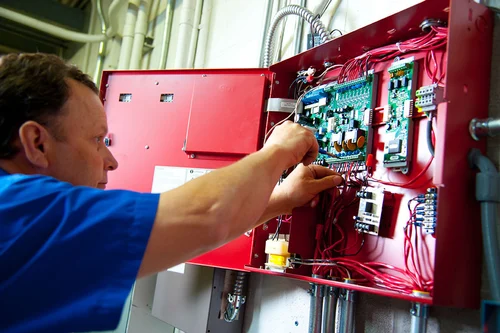In the realm of safety and protection, fire alarm systems stand as vigilant sentinels, poised to detect and announce the presence of the relentless and destructive force of fire. These indispensable guardians, often overlooked in their ubiquity, play a critical role in safeguarding lives and property. In this in-depth analysis, we delve into the intricacies of fire alarm systems, exploring their components, types, and the crucial role they play in mitigating the devastating impact of fires. At the heart of every fire alarm system lies a network of sensors attuned to the slightest hint of smoke or heat. Smoke detectors, the unsung heroes of fire prevention, come in two main types – ionization and photoelectric. Ionization detectors excel in detecting fast-burning fires, while photoelectric detectors are more adept at sensing slow, smoldering fires. The synergy of these sensor types ensures a comprehensive coverage, providing early detection regardless of the fire’s nature. The auditory backbone of fire alarm systems, alarms and notification devices, assume the responsibility of alerting occupants to the imminent danger. Evolving beyond the traditional blaring sirens, modern systems incorporate voice evacuation systems, delivering clear and concise instructions to guide people to safety.

Visual signals, such as strobe lights, further enhance accessibility for those with hearing impairments. The integration of these elements transforms a fire alarm system from a mere alert mechanism to a comprehensive emergency communication system. Fire alarm systems are not one-size-fits-all instead, they are tailored to the specific needs of diverse environments. In residential settings, conventional fire alarm systems often suffice, relying on basic detectors and alarms. In contrast, larger and more complex structures, like commercial buildings or industrial facilities, demand addressable systems. Addressable systems pinpoint the exact location of an activated sensor, allowing for a rapid and targeted response by emergency personnel. This level of precision is instrumental in minimizing response times and optimizing evacuation procedures. The rise of smart technology has ushered in a new era for fire alarm installation san antonio, enhancing their capabilities and accessibility. Connected systems can be monitored remotely, providing real-time updates to building management or emergency services. Moreover, the integration of artificial intelligence and machine learning enables predictive analysis, allowing systems to anticipate potential fire hazards based on historical data and environmental conditions.
These advancements underscore the ever-evolving nature of fire alarm technology, as it strives to stay one step ahead of the unpredictable nature of fires. While the primary goal of fire alarm systems is prevention and early detection, their effectiveness is contingent upon regular maintenance and testing. Routine inspections ensure that sensors, alarms, and communication devices are in optimal working condition, ready to spring into action at a moment’s notice. Additionally, advancements in self-testing technologies empower these systems to perform automated checks, reducing the burden on human operators and guaranteeing a higher level of reliability. Fire alarm systems serve as the unsung heroes of safety, standing as the first line of defense against the ferocity of fire. Through a meticulous integration of sensors, alarms, and cutting-edge technology, these guardians of the living flame exemplify the pinnacle of fire prevention and mitigation. Their constant vigilance and adaptability underscore their indispensable role in safeguarding lives and property, making them an enduring cornerstone of modern safety protocols.

Guardians of the Living Flame – An In-Depth Analysis of Fire Alarm Systems
January 7, 2024
Technology
Comments Off on Guardians of the Living Flame – An In-Depth Analysis of Fire Alarm Systems
Sean Hernandez
In the realm of safety and protection, fire alarm systems stand as vigilant sentinels, poised to detect and announce the presence of the relentless and destructive force of fire. These indispensable guardians, often overlooked in their ubiquity, play a critical role in safeguarding lives and property. In this in-depth analysis, we delve into the intricacies of fire alarm systems, exploring their components, types, and the crucial role they play in mitigating the devastating impact of fires. At the heart of every fire alarm system lies a network of sensors attuned to the slightest hint of smoke or heat. Smoke detectors, the unsung heroes of fire prevention, come in two main types – ionization and photoelectric. Ionization detectors excel in detecting fast-burning fires, while photoelectric detectors are more adept at sensing slow, smoldering fires. The synergy of these sensor types ensures a comprehensive coverage, providing early detection regardless of the fire’s nature. The auditory backbone of fire alarm systems, alarms and notification devices, assume the responsibility of alerting occupants to the imminent danger. Evolving beyond the traditional blaring sirens, modern systems incorporate voice evacuation systems, delivering clear and concise instructions to guide people to safety.
Visual signals, such as strobe lights, further enhance accessibility for those with hearing impairments. The integration of these elements transforms a fire alarm system from a mere alert mechanism to a comprehensive emergency communication system. Fire alarm systems are not one-size-fits-all instead, they are tailored to the specific needs of diverse environments. In residential settings, conventional fire alarm systems often suffice, relying on basic detectors and alarms. In contrast, larger and more complex structures, like commercial buildings or industrial facilities, demand addressable systems. Addressable systems pinpoint the exact location of an activated sensor, allowing for a rapid and targeted response by emergency personnel. This level of precision is instrumental in minimizing response times and optimizing evacuation procedures. The rise of smart technology has ushered in a new era for fire alarm installation san antonio, enhancing their capabilities and accessibility. Connected systems can be monitored remotely, providing real-time updates to building management or emergency services. Moreover, the integration of artificial intelligence and machine learning enables predictive analysis, allowing systems to anticipate potential fire hazards based on historical data and environmental conditions.
These advancements underscore the ever-evolving nature of fire alarm technology, as it strives to stay one step ahead of the unpredictable nature of fires. While the primary goal of fire alarm systems is prevention and early detection, their effectiveness is contingent upon regular maintenance and testing. Routine inspections ensure that sensors, alarms, and communication devices are in optimal working condition, ready to spring into action at a moment’s notice. Additionally, advancements in self-testing technologies empower these systems to perform automated checks, reducing the burden on human operators and guaranteeing a higher level of reliability. Fire alarm systems serve as the unsung heroes of safety, standing as the first line of defense against the ferocity of fire. Through a meticulous integration of sensors, alarms, and cutting-edge technology, these guardians of the living flame exemplify the pinnacle of fire prevention and mitigation. Their constant vigilance and adaptability underscore their indispensable role in safeguarding lives and property, making them an enduring cornerstone of modern safety protocols.